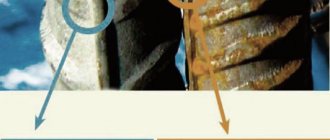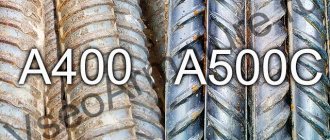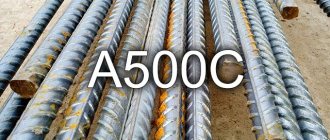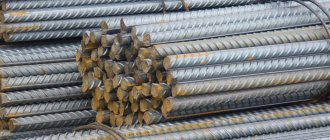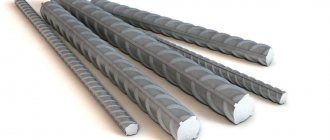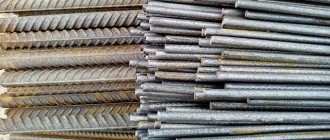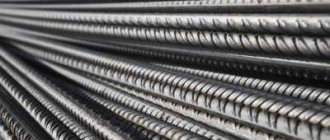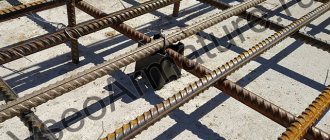Reinforcement made of different grades of steel with a wide range of thicknesses is used to reinforce concrete and brickwork. Portland cement is a versatile material for use in the construction of foundations, buildings, and much more. But it is prone to cracking and breaks when bending.
There was a need to take additional measures - to reinforce concrete. It provides tensile, torsional, and shear strength. At the same time, it is possible to reduce concrete consumption and, as a result, construction time.
Reinforced concrete products are a complex composite structure. Its structure contains reinforcement bars, which are surrounded by a concrete shell. The type of reinforcing bar profile and its geometric characteristics affect the strength of the product, its resistance to cracks and deformation.
Reinforcement classes
Since 2022, the new standard GOST 34028-2016 has been in force. Not only the designation of classes (1) has been changed. Old markings according to GOST 5781-82: A-I, A-II, A-III, A-IV, A-V, A-VI.
Table 1. Last positions - rope reinforcement.
Changes have also occurred in these indicators.
- Surface coating of reinforcement.
- Labeling.
- Bending-bending tests.
- The classes are not tied to a specific steel grade. Only its chemical composition is recommended. This allows you to react flexibly and implement innovations in the domestic and foreign steel industry.
- A direct ban has been introduced on the production of reinforcement from rails and sheet scraps.
- It is allowed to produce fittings with a profile shape different from the 4 standard ones.
Now, instead of meaningless Roman numerals behind the letter A: I, II, III, the yield strength is indicated: 240, 300, 500. The numbers indicate strength characteristics: yield strength in N/mm2. This is the ultimate load, after a slight excess of which irreversible plastic deformation begins, or, more simply, destruction.
The higher this indicator, the stronger the reinforcement.
For clarity, the recommended replacements are summarized in Table 2.
table 2
Another goal of the changes in the standard is to bring domestic and European requirements as close as possible.
Main settings
Operational
The main operational parameters include:
pressure :
- conditional - the highest excess operating pressure at a temperature of 20 ° C, which ensures long-term and safe operation of fittings and connecting parts of pipelines;
- working - the highest excess pressure at which long-term operation of fittings and connecting parts of pipelines is ensured at the operating temperature of the conductive medium;
- test - excess pressure at which the fittings and connecting parts of pipelines must be subjected to a hydraulic test for strength and density.
temperature throughput corrosion resistance type of drive required torque to control the valve response time, etc.
Structural and installation
The main design and installation parameters include:
- nominal passage diameter;
- building length and height;
- weight;
- type of connection to the pipeline;
- design and dimensions of connecting flanges;
- number, diameter and location of holes on the flanges;
- cutting for welding to the pipeline.
Construction materials:
Cast iron
- Gray cast iron;
- Ductile iron;
- High strength cast iron;
- Acid-resistant cast iron;
- Heat-resistant cast iron;
- Alkali-resistant cast iron;
- Anti-friction cast iron.
Steel
- Carbon steel;
- Alloy steel.
Non-ferrous metals and alloys
- Brass;
- Tinless bronze;
- Aluminum alloys;
- Nickel alloys;
- Titanium alloys;
Non-metallic structural materials
- Viniplast;
- Fluoroplastic-4;
- Polyethylene;
- Plastic compound based on polyvinyl chloride;
- Faolite A (acid-resistant plastic made on the basis of bakelite resin);
- Capron (Caprolactam);
- Acid-resistant ceramics;
- Glass;
- Porcelain;
- Melted diabase;
- Graphite materials;
- Textolite;
- Wood-laminated plastics.
- Gate valve
- Retraction
- Bent bend
- Flange
- Steel flanges: purpose, use, types
- Stainless steel flanges
- TsKBA designation system
- What are fittings?
- Pipeline fittings and its types
- Flange - a classic of pipeline connections
- Testing of shut-off valves
Functionality
For reinforcement of precast concrete, reinforcement up to class A600 is used. Classes above this are built into prestressed reinforced concrete structures.
Types of fittings by purpose.
- Working (longitudinal and transverse): accepts the main types of loads in a reinforced concrete product, the diameter is determined by calculations.
- Assembly (distribution and structural): for the formation of three-dimensional frames and meshes.
- Distribution: ensures the correct location of the working rods.
- Structural: not calculated; installed in places that may be subject to random loads.
- Anchor: for the formation of embedded elements, including gripping loops.
The consumption of reinforcement of all types in reinforced concrete structures ranges from 50 to 80 kg per cubic meter of concrete, but not less than 8 kg. The calculation of the required quantity for a strip foundation is given below.
Catalogs and directories
Pipeline parts catalog
Free distribution of paper catalogs upon request.
Catalog of ventilation and heating equipment.
Free distribution of paper catalogs upon request.
HSL LLC, a successful manufacturer of ball valves, continues to expand its product range. The 2017 catalog presents a new product section - “GAS EXTRACTION Riser TYPE LS 10.15.00.000”.
Updated TPK-Arm catalog released
The English-Russian dictionary of reinforcing terms has been compiled by TyazhPromKomplekt specialists to increase the efficiency of their own work, as well as to help the company’s clients.
The dictionary on pipeline fittings, seals and drive devices is published in this format for the first time in Russia. The authors hope that the proposed edition of the dictionary will provide effective assistance to a wide range of specialists, both developers and consumers of valves, as well as a large number of people involved in reading and translating technical literature, design documentation, operating manuals, installation, repair and dismantling of valves intended for various operating conditions. Researchers, graduate students, and undergraduates—future specialists in valve engineering—can expect significant assistance from the dictionary. St. Petersburg: Liton, 2007. - 308 p.
A5 format. 4 volumes. Edited by the Moscow Central Design Bureau of Valve Engineering. The directory contains: detailed technical characteristics of all types and types of pipeline fittings and drive devices (with sketches or dimensional drawings); names of manufacturers, their addresses and contact details; A product index that allows you to determine in which volume and on which page the information you are interested in is located.
Published since 1972. The directory contains a range of valve manufacturing products produced by enterprises in the Russian Federation and CIS countries. In this edition, unlike previous ones, information on the range of manufactured fittings has been clarified and expanded. The directory catalog is made in two volumes with a total volume of more than 1180 pages and contains information about pipeline fittings produced at 200 CIS enterprises. A4.2 volume format.
The book systematizes the information necessary for the selection, design and maintenance of pipeline fittings for various purposes. Typical designs of valves and actuators to them, assemblies and parts are considered. The characteristics of the materials used, data on a unified system of tolerances and landings, practical recommendations are outlined, the requirements and content of international, national and departmental standards of different countries are reflected. The directory is intended for engineering and technical workers of manufacturing enterprises, design and repair organizations in various fields of activity in industry, transport, agriculture and other sectors of the national economy, students and teachers of educational institutions, and young professionals. Year of publication: 2007, Number of pages: 463, Format: 70×100/8.
Marking
To inform consumers about the special properties of metal products, manufacturers additionally label them.
- A – rolled reinforcement.
- AP – rolled products for prestressed structures.
- H – increased category of plasticity.
- E – high plasticity for earthquake-prone areas.
- K – corrosion-resistant, with a protective coating (galvanized, galvanized).
- U – resistant to cyclic loads.
- C – weldable.
- T – compacted by thermal or mechanical means.
The letter designation of additional characteristics follows the numbers indicating the yield strength.
Markings are present on each rod. Each class is assigned a number (3)
Table 3
On one of the sides between profile ribs of increased thickness or ribs with a changed direction, ribs of normal size are considered. Their number - in accordance with Table 2 - means the class of the reinforcement.
Rice. 2
Rice. 3
The standard recommends such an encrypted designation, i.e. in practice you will encounter something else: cast numbers.
Rice. 4
In the accompanying documentation, fittings are designated by a set of numbers and letters. Let's look at a few examples.
- 10-A240 GOST 34028-2016. Smooth reinforcing bars in coils or bars with a diameter of 10 mm, class A240.
- 1f-12-A500 GOST 34028-2016. Periodic profile of the form 1f class A500, in rods or coils.
- 1f-12-A500SN. The same, weldable, increased ductility.
The marking may contain a measured (MD) or other length, production method.
Areas of use
Reinforcing smooth structures are the basis for the construction of composite structures based on concrete. With their help you can build various complex objects:
- Floors, foundations, simple and complex columns. In this case, the reinforcement acts as a foundation, which increases the overall strength of the constructed object.
- Beams, slabs, flights of stairs, elements of suspended supporting structures. Metal rods act as a “skeleton” to which all other structural elements are attached.
- Pillars, pipes, floor slabs, complex concrete-based parts. In this case, the reinforcement blocks complement the main structure, acting as a retainer or base.
Various parts and spare parts are also made from smooth reinforcement. These can be nuts, bolts, screws, lifting loops, fences, grounding elements. In practice, smooth reinforcement is often used together with corrugated reinforcement. This use allows you to strengthen the main structure - but also maintain its attractive aesthetic properties. For example, for the installation of hinged canopy blocks, corrugated reinforcement is used, which acts as the basis of the structure. At the same time, smooth reinforcement blocks can be installed in non-critical places - this helps to give the hinged canopy the desired look.
Delivery status
An area where the private developer almost always faces unpleasant discoveries.
The reinforcement is supplied in coils (up to 22 mm thick) and rods. The skein should consist of one, maximum two segments.
Length of rods: 6 - 18 m. Rods according to standard 34028-16 come in measured length (MD), measured with unmeasured (MD1), unmeasured (ND, 6 - 12 m). In the supply of MD1, no more than 3% of unmeasured rods with a length of at least 2 m are allowed.
Rods of irregular length are cheaper. But the probability of deception here is quite high. If it is not possible to count and measure each rod, you will pay more. Please also take into account that due to the overlap of individual rods, the consumption of reinforcement will increase.
The skeins should unwind freely, and the overlap of the turns should not interfere with unwinding.
Fittings for private housing construction
Of the 15 positions (Table 1), four are enough for an individual developer.
- A240 (Commonly AI). Hot rolled smooth. Distribution, anchor for embedded parts, diameter 6-8 mm. Bay.
- A400 (AIII). Hot rolled, periodic profile. Working, diameter 10-12 mm. Rods 12 m long.
- A500 (AIII). See point 2.
- В500 (ВрI). Wire for masonry, reinforcing mesh. Diameter 3-5 mm. In the form of ready-made meshes.
It is recommended to purchase fittings by the metre. This is time consuming. But it guarantees that exactly the footage that is needed is paid for.
When bending rods, it is recommended to adhere to the radii and angles indicated in Table 4 for welded reinforcement (C) with a special notch.
Table 4
These tables will help to distinguish low-quality fittings. Rods made from melted down rails break at smaller angles. It belongs to class 500.
A400 class rods cannot be welded; the bending angle should not exceed 90°.
Universal class
A500C is the most popular fittings. Due to its lower carbon content, it is perfectly welded together (including arc welding), which strengthens the frames for the concrete structure.
A reduced amount of alloying additives has increased ductility; brittleness is not inherent in it. This is clear from αmax, which is 180°. This additionally makes it possible to use this class as anchor reinforcement.
A500 can replace A400 without recalculating design loads. At the same time, reverse replacement only with a new calculation. Due to the increased strength of A500, up to 10% of material can be saved on reinforcement. This is a significant value for any project.
It is also important that the A500 is operated at -55 ° C, which is 10 ° lower than the A400.
Weldable reinforcement is 15% more expensive than conventional reinforcement of the same class. But the A500C is 6-8% cheaper than the A400. This is explained by the fact that steel for 500th due to the lack of alloying elements costs less.
Reinforcing wire
| Nominal diameter, mm | Design cross-sectional area, mm2 | Theoretical mass I m, kg, classes | Nominal diameter, mm | Design cross-sectional area, mm2 | Theoretical mass I m, kg, classes B - II, Bp-II | |
| B-I, B-II, Bp-II | Bp-I | |||||
| 3 | 7,06 | 0,056 | 0,052 | 6 | 28,3 | 0,222 |
| 4 | 12,56 | 0,099 | 0,092 | 7 | 38,5 | 0,302 |
| 5 | 19,63 | 0,154 | 0,144 | 8 | 50,3 | 0,395 |
Corrosion
The surface of a concrete structure must be looked after and any cracks that appear must be eliminated in a timely manner.
Due to the ability of iron to react with oxygen, steel products are inherently sensitive to the atmosphere. The interaction between it and oxygen in the air causes an oxidation process, more often called rust or corrosion.
Surface rust of the reinforcement that is located inside the structure does not affect its properties. The alkaline environment prevents this. It can even increase the bond between the bar and the concrete. However, a long process of surface oxidation (with access to air) can eventually lead to internal corrosion, which will inevitably weaken the steel bar.
The resistance of reinforcement to corrosion is determined by the chemical composition of the steel, the production method, and is designated by the letter K. In this case, the reinforcement is made of stainless steel. In private construction, it is irrational to use such rods.
It's not just about cost. Damage to the surface by metal slings or friction against the steel of the body creates pockets of corrosion.
Ferrous reinforcing metal is protected by hot-dip galvanizing or coating with epoxy resins.
Composite reinforcement
When choosing between steel and composite reinforcement, you must remember that the solidity of the structure depends on the adhesion (adhesion) of the rods to the concrete. For steel it is 0.18, for composite materials - 0.03 MPa.
In practice, this means that variable loads on the structure will sooner or later lead to separation of the concrete from the plastic.
Reinforcement with mineral and organic (aramid) bases are produced in accordance with GOST 31938-2012. Composite polymer reinforcement (CPF) contains such continuous fibers.
- Glass.
- Basalt.
- Carbon.
- Aramid (Kevlar).
The type is designated accordingly: ASK, ABK, AUK, AAK. There is also ACC - combined composite. They are bound into a durable structure with thermosetting (polyester, epoxy, phenolic) resins.
The profile is periodic. Standard diameters are from 4 to 32 mm, length 0.5 - 12 m. It does not bend or weld. But it is corrosion resistant, does not conduct electricity, and is not magnetic.
Experts treat her with distrust. First of all, because its production can be organized in a garage. It is difficult to achieve strict adherence to technological regimes in such conditions.
In private construction it is used to reinforce masonry. Especially if the solution is aggressive: it contains sulfates, chlorides (anti-freeze additives, accelerators). In non-critical structures: strip foundations, supporting walls, blind areas. For reinforcing floor screeds.
Ready-made spatial composite frames are available for sale. Standard or made to order according to individual sizes.
Reinforcement of ACP floors, crossbars, grillages requires serious design calculations. It is unlikely that you will be able to do it yourself, on your knee.
But if you want to try, here you go: SP 295.1325800.2017 Concrete structures, reinforced with ACP. Design rules.
Short description
Smooth reinforcement is a type of reinforcing bars without grooved stiffeners. Products of this type have a round cross-section; stiffening ribs, corrugated elements, external threads for smooth rods should be absent (according to GOST). It is used for reinforcing composite structures with low, medium or moderately high strength. Smooth reinforcement is not suitable for reinforcing heavy-duty structures; corrugated rods must be used instead.
Smooth reinforcing bars are used to strengthen beams, slabs, and columns. Another area of application is the creation of cast structures based on concrete. You can create both individual reinforcing elements and a stiffening mesh (square, rectangular, triangular, complex shape). It is manufactured in the form of individual rods, the length of which is usually from 1 to 5 meters. The cross-sectional diameter ranges from 6 to 40 millimeters. The weight of each product depends on its length and cross-section diameter. 1 meter of a product with a thickness of 6 millimeters is 0.22 kg - while the weight of 1 meter of a rod with a thickness of 40 millimeters will be 39.5 kg.
